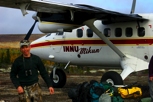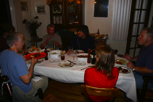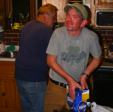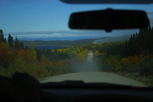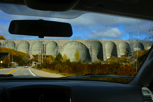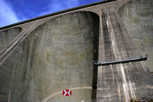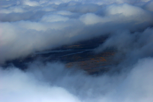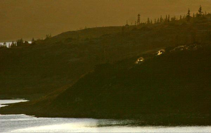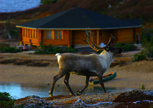
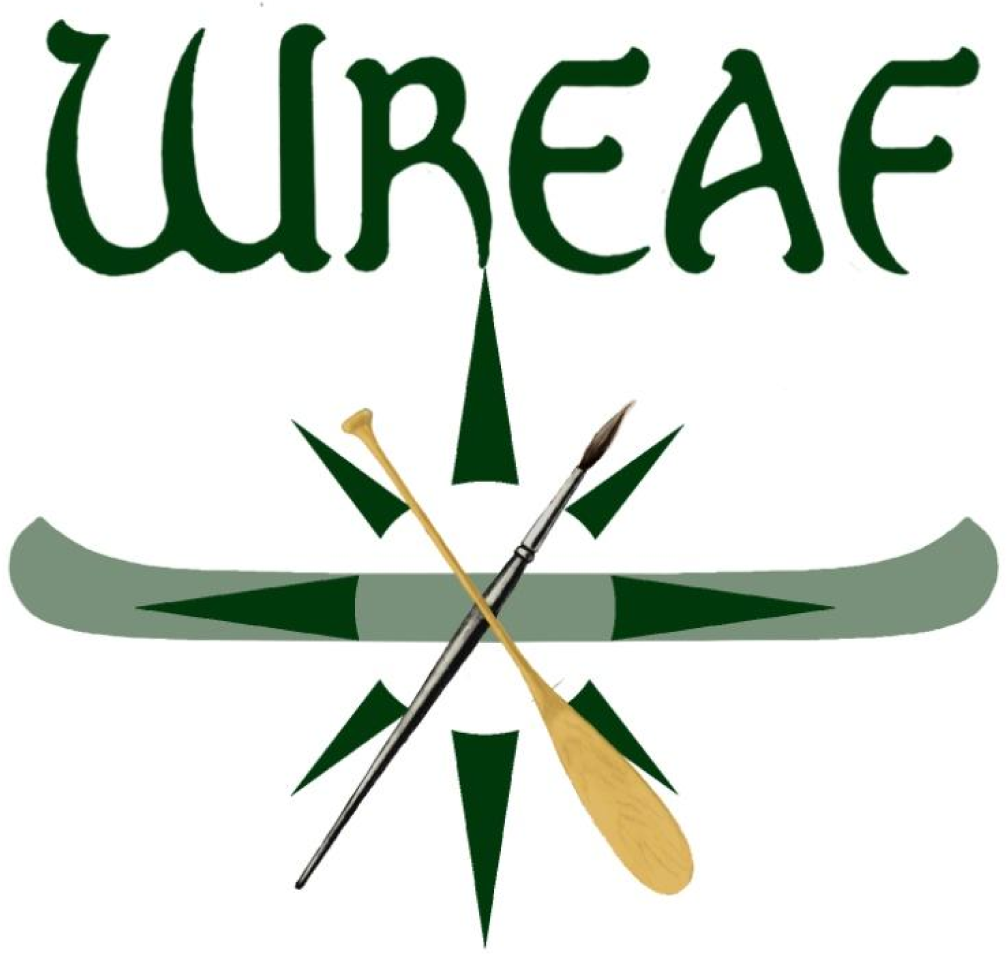
Lake Kamestatin, Labrador:
September 29-October 18, 2008
Sponsored by the Canadian Wildlife Federation
Crew:
Jordanna Benuen: Labrador - Innu guideLinda Besse: Washington - New Artist
Cole Johnson: New York - New Artist
Jay Johnson: Massachusetts - New Artist
Gary McGuffin: Ontario
Rob Mullen: Vermont
Steve Oliver: Pennsylvania - New Artist
John Pitcher: Vermont
Sue Westin: Vermont - New Artist
Tony Jenkinson: Labrador
September 28, 2008
The artists on the crew assembled at WREAF member Bonnie Rowell's house in Montreal where her tenant Pierre Pellicer prepared a gourmet send off dinner; hopefully a new WREAF tradition.
September 29
We departed Montreal and headed for Goose Bay. The route included a scenic drive along the Quebec Northshore that interestingly included a meteorite impact crater along the St. Lawrence. The Charlevoix crater is about ten times older than the Kamestastin crater (350 million as opposed to 38 million +/- a few million years), much larger and harder to see. On the ferry at Tadoussac we saw Beluga Whales, then after a night in Baie Comeau we headed north into the interior.
September 30
The drive this day took us through yet another meteorite impact crater. If we had been there 212 million years earlier we'd have been obliterated by the impact as it left a crater 62 miles in diameter. The Manicouagan crater is now a reservoir created by the largest multiple arch and buttress dam in the world; the Manic 5 dam on the Manicouagan River. This was one of two major hydroelectric installations we saw on our drive. Hydro development is one of the major challenges facing the Boreal Forest. It also marked where we lost the paved road for most of the rest of the drive. Just before we stopped for the night we passed the mammoth iron mine just on the Quebec side of the border; another up close view of a major challenge facing the Boreal.
October 1
After a night in Labrador City we headed off onto the Labrador Highway, the dust now turned to mud as the light rain of the previous afternoon had strengthened overnight into a soaker. After refueling in Churchill Falls we passed the generating station; one of the largest in the world and built upon one of the greatest waterfalls in Canada....well formerly so anyway. Now water flows over Churchill Falls only occasionally. Crossing a bridge over the skeletal remains of the Churchill was a forlorn experience.
We arrived in Goose Bay at dinner time. Our plan was to fly out the next day and meet up with Dr. Loring and Tony Jenkinson at the camp. It was quite a surprise therefore when Dr. Loring drove in as we were unpacking at the hotel, waving a friendly hello. Travel in the North requires flexibility and this trip was to be no exception.
Dr. Loring's field survey had been aborted due to high winds and associated problems and they had come out early. Stephen joined us for dinner and afterward we talked to Tony Jenkinson who agreed to accompany us to Kamestastin with his granddaughter Jordana.
October 2
Despite some last minute excitement getting all ten of us on the plane in time we took off on the Innu Mikun Twin Otter around 11:30 am. The flight was above cloud for the most part but we had occasional teasing peeks at the landscape unfolding below us. It wasn't until we started descending into the crater that we could clearly see the tundra hurtling past a short way under the landing gear. The landing strip at Lake Kamestastin was built by Stephen and is quite unique; it curves (eskers do that sometimes). It was an exciting landing as we banked steeply over the lake and made our first approach. The pilot apparently didn't like the set up and veered off. He lined it up again as we all got another intimate look at the islands at the narrow end of the lake. It is bumpy landing on a rough tundra airstrip carved into an esker. Tony said that sometimes the pilots will make six or seven passes before setting down so that we actually fared quite well.
Getting to camp was a bit of a job; the strip is over a mile from the camp and there were no outboards running at the time. We had been expecting several Innu families to be encamped for their caribou hunt but Tony said they were all still somewhat south of us at Border Beacon. We had the place to ourselves so we settled into the cabins and unpacked.
The next several days brought a variety of weather. It had been unusually warm, clear and calm upon our arrival - almost as though someone were trying to lure us into a false sense of serenity. October 3 dawned with hard wind and rain with low temps. Nonetheless a few of the crew could not contain their enthusiasm and set forth. The rain eased after that though the skies were largely overcast with sometimes truly awesome wind.
The search for caribou was on... for six days.The difficulty in finding caribou was frustrating, but we are all artists; able to find inspiration where others might only see a barren rocky windswept tundra.....devoid of any living thing; right?
Right.
So we focused on the land. It has an alien beauty that can absorb you and which feels wondrously timeless -
liberating and peaceful - yet with an undercurrent of ominous threat too - this place is truly wild, one too many
mistakes could be the end of you. Some of us traveled alone at times but only with the greatest care and respect.
Of course, the land was not lifeless. Several of us saw wolves at a distance, porcupines, Golden Eagles, Gyr-Falcons, Crossbills, Ravens, Loons, Golden-eyes, Boreal Chickadees, Redpolls, Water Pipits, Common Mergansers, Geese and even one Snowy Owl. Then there were the Ptarmigan! We spent several forays specifically targeting these wily "Tundra Chickens" with Cole the Master of the Hunt in light of his initial encounter with over a hundred of them.
And Then There Were Caribou
On October 8 (our first clear day) Rob had decided to make the long hike out to a gorge near where Stephen had suggested was a good place to portage to the Kogaluk (a future trip). Tony agreed that it would be a good area to scout for caribou sign as well and John decided to join him. They never made it to teh gorge. Over the course of the day they were distracted by over 500 caribou. Of course, the big day was yet to come.
October 11
We'd all first seen caribou in any numbers on the 8th of October and had all had some fantastic encounters since. On this particular morning Linda, Cole and Steve had just headed off for a planned long trek through the river bottom east of the lake where John and Rob had first encountered high numbers of caribou. Gary was setting up a shot, John and Sue were still in their cabin and Tony, Jay and Rob were having coffee in the Guide Cabin.
Suddenly Tony calmly exclaimed, "Caribou - hundreds of them". Gary came in just a few seconds later with the same news having seen them while working outside. There was a scramble for gear and Rob ran to John and Sue's cabin to make sure they got the word. Happily Linda, Steve and Cole hadn't gone too far; in fact they were in perfect position to intercept the first wave as it came ashore. Tony estimated the first mass at about 700 and they just kept coming all morning.
The Caribou Dance
Of course, getting them not to see you as a threat is the rub.
Running around in the open in a crouch or sneaking bush to bush just makes you look like a neurotic wolf and the vibe
you put out is certainly predatory.
Our favorite technique is not to act like a predator at all; an effective way to do that is the Caribou Dance.
It is mildly embarrassing to do in public but if self-conscious self-respect is thrown to the wind you will have all the attention from caribou you could want; maybe more...
Like in all of life the key is balance; you don't want them too curious, especially...
When the bulls are in rut.

